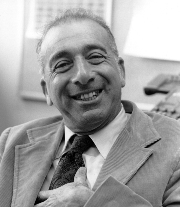Bernie Alder
Bernie Julian Alder (born September 9, 1925 in Duisburg ) is an American physicist who deals with statistical mechanics and is a pioneer of numerical simulation in physics.
Live and act
Alder was born as a Swiss citizen in Germany, moved with his family to Switzerland after the Nazis came to power and in 1941 to the USA, where he studied chemistry at the University of Berkeley , interrupted by a time in the US Navy during World War II (Bachelor 1946, Master 1947).
In 1948 he went to Caltech to John G. Kirkwood , where he independently found the Monte Carlo method for the investigation of phase transitions in hard-sphere gas models (model of rigid spheres) with Stan Frankel (1919–1978) .
After receiving his doctorate in 1952, he went to Berkeley University and at the same time worked at the suggestion of Edward Teller as a consultant in the nuclear weapons program for the Lawrence Livermore National Laboratory (design of equations of state). In collaboration with Thomas E. Wainwright (1927–2007), he developed the molecular dynamics simulation method in the mid-1950s . Among other things, they were able to show the transition from the liquid to the solid state in the hard-sphere gas model or the decay of velocity autocorrelation functions in liquids.
Alder was later Professor of Applied Sciences at the University of California at Davis , now as Professor Emeritus.
In 1970 he was elected a Fellow of the American Association for the Advancement of Science and a member of the National Academy of Sciences . In 1985 he was honored by the American Chemical Society with the Joel Henry Hildebrand Award in the Theoretical and Experimental Chemistry of Liquids for his outstanding achievements in the theory of liquids . In 2001 he received the Boltzmann Medal for inventing the molecular dynamics simulation method
In 2008 he was elected to the American Academy of Arts and Sciences before receiving the National Medal of Science in 2009 .
Alder was a Guggenheim Fellow. He was editor of the book series Methods in Computational Physics and founder of the journal Computing .
Fonts
- with Wainwright: Molecular motions, San Francisco: WH Freeman, 1959.
Web links
Remarks
- ↑ Interview with George Michael 1997. Frankel carried out the calculations on the Ferranti computer in Manchester in 1950, as Kirkwood did not trust the results but nothing was published. Teller, Rosenbluth and Metropolis mention them as independent explorers in a footnote to their work.
- ↑ Alder, Wainwright Phase transition for a hard sphere system , J. Chem. Phys., Vol. 27, 1957, pp. 1208-1209. He had already shown the existence of the phase transition with Frankel using the Monte Carlo method, which, however, was not accepted by Kirkwood at the time.
- ↑ Examples: Alder, Wainwright Phase transition in elastic disks , Physical Review Vol. 127, 1962, p. 359, Decay of the velocity autocorrelation function , Physical Review A, Vol. 1, 1970, p. 18
- ^ Joel Henry Hildebrand Award. List of award winners. American Chemical Society, accessed October 3, 2017 .
- ↑ Literally in the award ceremony: "For inventing the technique of molecular dynamics simulation and showing that with such" computer experiments "important discoveries in the field of statistical mechanics can be made, in particular the melting / crystallization transition of hard spheres and the long- time decay of auto-correlation functions in fluids. "
- ↑ Book of Members 1780 – present, Chapter A. (PDF; 945 kB) In: American Academy of Arts and Sciences (amacad.org). Retrieved October 3, 2017 .
- ^ Berni Alder receives the National Medal of Science . Lawrence Livermore National Laboratory. September 18, 2009. Archived from the original on May 27, 2010. Info: The archive link was automatically inserted and not yet checked. Please check the original and archive link according to the instructions and then remove this notice. Retrieved February 12, 2010.
| personal data | |
|---|---|
| SURNAME | Alder, Bernie |
| ALTERNATIVE NAMES | Alder, Bernie Julian (full name) |
| BRIEF DESCRIPTION | American physicist |
| DATE OF BIRTH | September 9, 1925 |
| PLACE OF BIRTH | Duisburg |
